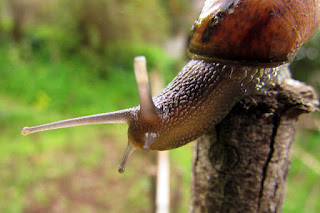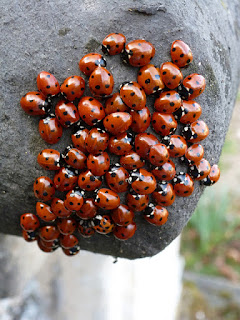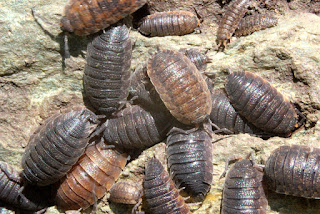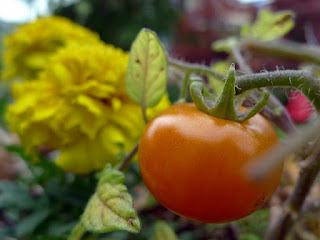As I peacefully garden, random thoughts about the wildlife I encounter waft through my head. How far does a hedgehog travel in a night? If you throw a snail over the fence, is it likely to find its way back into the garden? How long do worms live? Rather than continue repeating this cycle of speculation, I decided to get to the bottom of these little mysteries.
Do those snails make it back over the fence?
There are 43,000 species of Gastropoda (the taxonomic group better known as slugs and snails). There are 220 non-marine species of these mucous crawling critters living in the UK, so it’s small wonder we have such problems with snails in our gardens. Snails can live up to three years. Each snail has both male and female sex organs (they are hermaphrodites) and mating occurs when two entwined snails each shoots a small sperm-carrying dart at the other; each then goes off to lay about 40 eggs.
 |
Garden snail.
Photo credit: Daniela [via Flickr, CC license] |
And that burning question….what happens to all those snails that I catapult over my fence? Well yes, snails can happily find their way back over fences and walls, up to a distance of 10 metres.
Professor Dave Hodgson, Professor of Ecology,
University of Exeter, revealed this fact when he used LED lights and UV paint to track the movement of snails at night in a British garden.
The study revealed that snails can travel distances of up to 25 metres during a 24-hour period and reach top speeds of one metre per hour. So you will need to do more than lob them discretely over the wall if you are hoping to do more than just make them work a bit harder for their supper!
What is the lifespan of a slug?
Most slugs evolved from snails, losing their shells through evolutionary processes over time.
Depending on the species, slugs can live between 1 and 5 years. If you are squeamish about slugs, count your blessings you don’t live in North America where there is the banana slug, which grows to 10 inches long!
Much as we may berate slugs, they do serve an important function in nature, munching up rotting debris and recycling the nutrients back into the food chain.
However, they also like to munch the tender leaves and stalks of our most treasured little seedlings, and it is for this reason that many British gardeners are keen to shorten the lifespan of these troublesome pests. Use of slug baits is highly controversial and there is insubstantial and conflicting information regarding how these poisons affect other creatures, such as birds and hedgehogs, which are natural predators of slugs.
Despite being in widespread use, slug pellets are considered by some to be a relatively ineffective method of slug control, some say killing no more than 10% of the slug population in the average garden. Slug pellets fall into 2 main types; those containing metaldehyde or the less common methiocarb.
Metaldehyde is the most common and less toxic form of slug poison and if not taken in too large quantities less likely than methiocarb products to be fatal to other animals – the suggested dose being one pellet every 10 cm (4”).
Methiocarb is about ten times more poisonous than metaldehyde, and therefore of greater danger to other animals. It breaks down more slowly too, making it a longer lasting hazard in the environment with the potential to affect more animals (targeted or not).
The
RHS has some research underway that is due to report in December 2017 on the relative effectiveness of different methods of slug and snail control, including the use of nematodes. This research will help them improve their advice about slug and snail control.
Does cutting a worm in half make 2 worms?
Sadly no – but thankfully at least one half should still survive.
 |
Earthworms
Photo credit: Wormwould [via Flickr CC by-NC 2.0] |
I always say the common earthworm is the hardest worker in the garden, and Charles Darwin called them ‘nature’s ploughs’. They do an extraordinary job of aerating and fertilising the soil, pulling leaves down beneath the ground at a rapid rate and bringing valuable minerals to the surface with their wormcasts. One acre of land can hold around 3 million earthworms, which are capable of bringing around 9 tonnes of soil to the surface through their wormcasts in just one year. The tunnels they make and live in can go as deep as 1.8 m (6 ft), which enables them to find moisture in times of drought. Worms are capable of digesting even leaves that are generally poisonous, owing to the presence of a chemical in their gut called drilodefensins. Scientists at
University College London identified this molecule, which breaks down the toxic chemicals plants produce to deter herbivores. Without this ability, leaves would pile up on the surface of the soil.
How many spots does a ladybird have?
Well, actually, there are 40 different species of ladybirds in Britain, with differing numbers of spots and some have yellow wing cases rather than red – the invasive harlequin ladybird (Harmonia axyridis) can also have a black wing case. And no, ladybirds do not gain more spots as they get older. The ladybird is a most welcome addition to the garden as its larvae munch their way through vast quantities of aphids prior to pupating. However, they have to eat heartily as aphids are so fast at reproducing, they get through three generations for every single generation of ladybird. For this reason, the ladybird’s ability to truly help control aphid infestations has been brought into question.
Is the common wood lice harmful to plants?
An unfortunate name for a little creature that is more closely related (admittedly from way back), to crabs and lobsters! It quietly beavers away eating rotten wood, fungi and garden debris and protects itself from drying up by only coming out from under stones and logs at night.
Woodlice cause little or no damage to plants. Large numbers can be found in compost heaps, where they help break down the plant material and are a useful part of the composting process. But you may well have seen what you think is the same thing around your house. This is a slightly different species of wood louse to the garden variety and is called the pill bug. It can be distinguished from the woodlouse by its tendency to roll into a tight ball when threatened. Pill bugs are not thought to do any harm in the house although their presence may indicate an issue with dampness, as this is their preferred environment.
How can you tell the difference between toads and frogs?
I have often wondered how to tell which was which. Frogs generally have a wet, smoother skin, while that of toads is dry and ‘warty.’ Toads walk rather than leap and are less nimble movers than frogs. I regularly help with a garden in Herefordshire where I am frequently surprised by the lump of soil that turns out to be a toad that then ambles off unsteadily down the garden – a frog would have leapt off at the least disturbance.
Toads return each year to the same pond to spawn their eggs – as many as 7,000 in a sitting.
Frogs come in a much wider range of colours than the steady brown toad with its darker brown blotches; they can be anything from yellow, brown, orange, red, grey, and different shades of speckling.
What ARE Nematodes?
 |
Caenorhabditis elegans is a nematode that is studied
extensively by scientists.
Photo credit:snickclunk [via Flickr CC by-NC 2.0] |
Nematodes are microscopic worms that are naturally present in the soil. They can be purchased in concentrated volumes as biological pest control. There are specific nematodes for each different garden ‘pest’ such as slugs, vine weevils, ants, chafer grubs, leatherjackets, caterpillars, codling moth etc. An advantage of nematodes is that they don’t persist in the environment like chemicals do – when their prey item depletes, they naturally die off to natural population levels.
As this is a ‘live’ product, it is currently only available from online suppliers as nematodes have to be used within a few days of purchase. They are sent in a little pack that resembles fresh yeast and one simply has to dilute this to the required level and then water them into the garden. I have used nematodes myself very successfully and believe that with increasing regulatory pressure on toxic sprays and treatments that are harmful to pollinators and other wildlife, nematodes are the way of the future for pest control.
Please leave a comment if you have any questions about the wildlife you encounter in your garden and we’ll do our very best to find an answer. Part 2 will have some common questions about our furred and feathered garden friends.


















